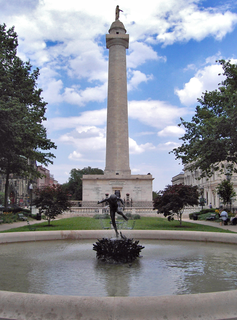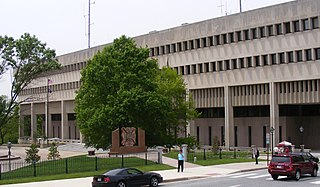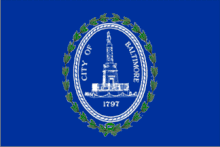
Cecil Calvert, 2nd Baron Baltimore, also often known as Cecilius Calvert, was an English nobleman, who was the first Proprietor of the Province of Maryland, ninth Proprietary Governor of the Colony of Newfoundland, and second of the colony of Province of Avalon to its southeast. His full title was "First Lord Proprietary, Earl Palatine of the Provinces of Maryland and Avalon in America". He received the proprietorship after the death of his father, The 1st Baron Baltimore, for whom it had been intended. Cecil, Lord Baltimore, established and managed the Province of Maryland from his home, Kiplin Hall, in North Yorkshire, England. As an English Roman Catholic, he continued the legacy of his father by promoting religious tolerance in the colony.

Baron Baltimore, of Baltimore, County Longford, was a title in the Peerage of Ireland. It was created in 1625 and ended in 1771, upon the death of its sixth-generation male heir, aged 40. Holders of the title were usually known as Lord Baltimore for short.

The flag of Delaware consists of a buff-colored diamond on a field of colonial blue, with the coat of arms of the state of Delaware inside the diamond. Below the diamond, the date December 7, 1787, declares the day on which Delaware became the first state to ratify the United States Constitution. The colors of the flag reflect the colors of the uniform of General George Washington.

The flag of the state of Maryland is the 17th-century heraldic banner of arms of Cecil, 2nd Baron Baltimore. It consists of the arms of his father George, 1st Baron Baltimore (1579–1632), quartered with those of his grandmother, heiress of the Crossland family. The flag was officially adopted by the General Assembly of Maryland in 1904.

Edwin Warfield was an American politician and a member of the United States Democratic Party, and the 45th Governor of Maryland in the United States from 1904 to 1908.

Elihu Emory Jackson, a member of the United States Democratic Party, was the 41st Governor of Maryland in the United States from 1888 to 1892. He was born in 1837 in Delmar, Maryland and died in 1907 in the City of Baltimore, Maryland. He is buried at the Parsons Cemetery in Salisbury, Maryland, the county seat of Wicomico County. He was part owner of Pemberton Hall, listed on the National Register of Historic Places in 1971.

The Great Seal of the State of Maryland is the official government emblem of the U.S. state of Maryland. Its official service is to authenticate acts by the General Assembly of Maryland, but it is also used for display purposes at most state buildings. Although the state seal has been changed in design several times throughout history, the current model represents the reverse side of the original seal.

The Washington Monument is the centerpiece of intersecting Mount Vernon Place and Washington Place, an urban square in the Mount Vernon-Belvedere neighborhood north of downtown Baltimore, Maryland. It was the first major monument begun to honor George Washington (1732–1799).

The city flag of Los Angeles consists of a background of three notched stripes of green, gold and red. The flag was designed by Roy E. Silent and E.S. Jones in 1931 for the Los Angeles sesquicentennial from 1781.

The Seal of Baltimore is the official government emblem of the city of Baltimore, Maryland. The current City Seal was adopted for use in 1827, possibly inspired by a famous speech and toast made by sixth President John Quincy Adams (1767-1848) / [served 1825-1829], on a visit and tour in 1827, in which he dubbed the city with its most well-known nickname of "The Monumental City", with the recent erection of several monuments, including this for the War of 1812 and the new Washington Monument column, nearing completion in a wooded park, just north of the booming city. The seal is in the shape of an ellipse with the image of the Battle Monument featured in its center The iconic monument, designed by Frenchman J. Maximilian Godefroy, (1765-c.1838), erected 1815–1822, in the former colonial era Courthouse Square for the casualties suffered during the recent War of 1812 when the British invasion with a land/sea attack in September 1814, in the Battle of Baltimore, with the land conflict southeast of the city on the Patapsco Neck peninsula with several thousands of the King's Army at the Battle of North Point and the subsequent Royal Navy fleet blockade and bombardment of Fort McHenry, south of the town, protecting the entrance to the Patapsco River of Baltimore harbor.

The flag of Pittsburgh, Pennsylvania, is a triband flag featuring vertical bands of black and gold and the city's coat of arms in the center.

The Maryland Army National Guard is the United States Army component of the U.S. state of Maryland. It is headquartered at the old Fifth Regiment Armory at the intersection of North Howard Street, 29th Division Street, near Martin Luther King, Jr. Boulevard in Baltimore and has additional units assigned and quartered at several regional armories, bases/camps and other facilities across the state.

The Battle Monument, located in Battle Monument Square on North Calvert Street between East Fayette and East Lexington Streets in Baltimore, Maryland, commemorates the Battle of Baltimore with the British fleet of the Royal Navy's bombardment of Fort McHenry, the Battle of North Point, southeast of the city in Baltimore County on the Patapsco Neck peninsula, and the stand-off on the eastern siege fortifications along Loudenschlager and Potter's Hills, later called Hampstead Hill, in what is now Patterson Park since 1827, east of town. It honors those who died during the month of September 1814 during the War of 1812. The monument lies in the middle of the street and is between the two Baltimore City Circuit Courthouses that are located on the opposite sides of North Calvert Street. It was sponsored by the City and the "Committee of Vigilance and Safety" led by Mayor Edward Johnson and military commanders: Brig. Gen. John Stricker, Maj. Gen. Samuel Smith and Lt. Col. George Armistead.

The Baltimore City Circuit Courthouses are state judicial facilities located in downtown Baltimore, Maryland. They face each other in the 100 block of North Calvert Street, between East Lexington Street on the north and East Fayette Street on the south across from the Battle Monument Square (1815-1822), which held the original site of the first colonial era courthouse for Baltimore County and Town, after moving the Baltimore County seat in 1767 to the burgeoning port town on the Patapsco River established in 1729-1730.

The Baltimore County Courthouses are located in Towson, the county seat. The older, original Baltimore County Courthouse of 1854-1856 houses many of the offices of the County government, including both the executive branch and the legislative branch. The County Courts Building lies to the west, separated by a plaza. Built in 1970-1971, it houses the civil, criminal, family and juvenile divisions of the Circuit Court of Maryland for Baltimore County, as well as the Baltimore County Sheriff's Office. The latter office protects the Courthouse and its judicial personnel, as well as having countywide law enforcement functions.

The First Unitarian Church is a historic church and congregation at 12 West Franklin Street in Mount Vernon, Baltimore, Maryland. Dedicated in 1818, it was the first building erected for Unitarians in the United States. The church is a domed cube with a stucco exterior. The church, originally called the "First Independent Church of Baltimore", is the oldest building continuously used by a Unitarian congregation. The name was changed in 1935 to "The First Unitarian Church of Baltimore " following the merger with the former Second Universalist Church at East Lanvale Street and Guilford Avenue in midtown Baltimore. The American Unitarian Association and the Universalist Church of America (established 1866) representing the two strains of Unitarian Universalism beliefs and philosophies merged as a national denomination named the Unitarian Universalist Association in May 1961.

Seton Hill Historic District is a historic district in Baltimore, Maryland. It was listed on the National Register of Historic Places in 1975.

J. Maximilian M. Godefroy was a French-American architect. Godefroy was born in France and educated as a geographical/civil engineer. During the French Revolution he fought briefly on the Royalist side. Later, as an anti-Bonaparte activist, he was imprisoned in the fortress of Bellegarde and Château d'If then released about 1805 and allowed to come to the United States, settling in Baltimore, Maryland, where he became an instructor in drawing, art and military science at St. Mary's College, the Sulpician Seminary. By 1808, Godefroy had married Eliza Crawford Anderson, editor of her own periodical, the Observer and the niece of a wealthy Baltimore merchant.

The flag of Austin is the official municipal flag of Austin, Texas. The flag simply consists of a white field with the seal of Austin without the surrounding circle of text. Below the seal of Austin is the text, "CITY OF AUSTIN", written in blue and arched upwards.

The flag of Raleigh is the official municipal flag of Raleigh, North Carolina. It is perhaps the only American city flag to feature different designs on the obverse and reverse. Both sides feature a similar red-white-red vertical triband with an emblem in the center. The obverse features the Seal of Raleigh. The reverse has a modified version of the coat of arms of Sir Walter Raleigh.

 Flag of Baltimore 1899–1915
Flag of Baltimore 1899–1915





















